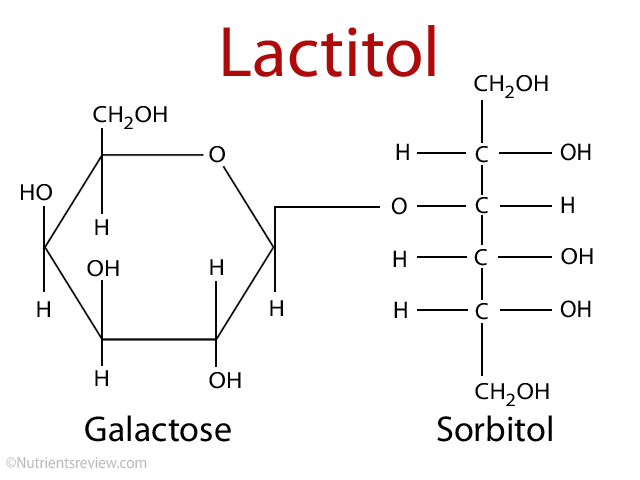- Lactitol Calorie Control Council
- Mitchell, H., 2006, Sweeteners and Sugar Alternatives in Food Technology
- Current EU approved additives and their E Numbers Food Standards Agency
- Lactitol Drugs.com
- Sugar alcohols The Sugar Association
- Lactitol Toxnet
Lactitol
What is lactitol?
Lactitol is a poorly digestible carbohydrate, namely a sugar alcohol composed of galactose and sorbitol; it is produced by hydrogenation of lactose, which is derived from whey [5].
Lactitol Formula
Picture 1. Lactitol structure compared to glucose
Nutrition Facts
- Calories per gram = 2
- Glycemic index (GI) = 5
- Sweetness, relative to sucrose = 40%
- Net carbs = zero
Lactitol Uses
Lactitol is used as a sweetener and texturizer in sugar-free foods, such as ice cream, chocolate, candies, baked goods, pre-prepared pasta, frozen fish, chewing gums, infant formula, medical tablets [1]. In the European Union it is labeled as E number E966 [3]. Lactitol is also allowed in Canada, Australia, Japan and some other countries [2-p.220].
Lactitol monohydrate syrup is used as a laxative [4].
Lactitol Digestion and Metabolism
Only about 2% of the ingested lactitol is digested in the small intestine to glucose and sorbitol, which are absorbed, the rest passes to the large intestine where it is fermented by colonic bacteria to gases, short-chain fatty acids (SCFA) and lactic acid, which are partly consumed by bacteria and partly absorbed [1,2-p.211]. Lactitol can provide 2 kilocalories per gram [2-p.211]. Lactitol attracts water from the intestinal wall (osmotic effect) so it can cause diarrhea if consumed in excess. According to The Scientific Comittee on Food to the EC (SCF-EC), consumption of 20 grams lactitol per day should not have a laxative effect [2-p.212].
Possible Lactitol Benefits
Tooth decay. Lactitol is not readily metabolized by the mouth bacteria so it does not promote dental caries [1,2-p.216].
Diabetes mellitus. Lactitol has a low glycemic index (GI = 5); it has a negligible effect on blood glucose or insulin levels [1,2-pp.9,215].
Lactitol Safety
Lactitol is safe to use according to World Health Organization’s Joint Expert Committee on Food Additives (JECFA) [1]. In the United States, Generally Recognized As Safe (GRAS) affirmation petition for the use of lactitol in foods was accepted by the US Food and Drug Administration (FDA), which means, lactitol is allowed to be used in food products in the U.S; however, lactitol (as of y. 2014) is not yet GRAS [1].
Side Effect and Dangers
Lactitol in large amounts may cause bloating and diarrhea.
Lactitol and Cooking
Physical properties:
- Lactitol is commercially available as a dry anhydrous lactitol or lactitol monohydrate, which contains water; both appear as white crystalline powders [1,2-p.205,5].
- 40% as sweet as sucrose and has almost no cooling effect [1]
- Not hygroscopic – does not readily attract moisture from the air [1,2-p.210]
- Solubility in water at 77 °F (25° C) = 57 g/100 g solution [2-p.158]
- Melting point = 295° F (146° C) [6]
- Heat stability >320° F (>160° C) [2-p.158]
- Does not undergo the Maillard browning reaction [2]
Related Nutrients
- Sugar alcohols (polyols):
- Sugars: Tagatose
- FODMAPs
Carbohydrates
- Fructose
- Galactose
- Glucose
- Isomaltose
- Isomaltulose
- Lactose
- Maltose
- Mannose
- Sucrose
- Tagatose
- Trehalose
- Trehalulose
- Xylose
- Erythritol
- Glycerol
- Hydrogenated starch hydrolysates (HSH)
- Inositol
- Isomalt
- Lactitol
- Maltitol
- Mannitol
- Sorbitol
- Xylitol
- Fructo-oligosaccharides (FOS)
- Galacto-oligosaccharides (GOS)
- Human milk oligosaccharides (HMO)
- Isomalto-oligosaccharides (IMO)
- Maltotriose
- Mannan oligosaccharides (MOS)
- Raffinose, stachyose, verbascose
- SOLUBLE FIBER:
- Acacia (arabic) gum
- Agar-agar
- Algin-alginate
- Arabynoxylan
- Beta-glucan
- Beta mannan
- Carageenan gum
- Carob or locust bean gum
- Fenugreek gum
- Galactomannans
- Gellan gum
- Glucomannan or konjac gum
- Guar gum
- Hemicellulose
- Inulin
- Karaya gum
- Pectin
- Polydextrose
- Psyllium husk mucilage
- Resistant starches
- Tara gum
- Tragacanth gum
- Xanthan gum
- INSOLUBLE FIBER:
- Cellulose
- Chitin and chitosan
- FATTY ACIDS
- Saturated
- Monounsaturated
- Polyunsaturated
- Short-chain fatty acids (SCFAs)
- Medium-chain fatty acids (MCFAs)
- Long-chain fatty acids (LCFAs)
- Very long-chain fatty acids (VLCFAs)
- Monoglycerides
- Diglycerides
- Triglycerides
- Vitamin A - Retinol and retinal
- Vitamin B1 - Thiamine
- Vitamin B2 - Riboflavin
- Vitamin B3 - Niacin
- Vitamin B5 - Pantothenic acid
- Vitamin B6 - Pyridoxine
- Vitamin B7 - Biotin
- Vitamin B9 - Folic acid
- Vitamin B12 - Cobalamin
- Choline
- Vitamin C - Ascorbic acid
- Vitamin D - Ergocalciferol and cholecalciferol
- Vitamin E - Tocopherol
- Vitamin K - Phylloquinone
- Curcumin
- FLAVONOIDS:
- Anthocyanidins
- Flavanols: Proanthocyanidins
- Flavanones: Hesperidin
- Flavonols: Quercetin
- Flavones: Diosmin, Luteolin
- Isoflavones: daidzein, genistein
- Caffeic acid
- Chlorogenic acid
- Lignans
- Resveratrol
- Tannins
- Tannic acid
- Alcohol chemical and physical properties
- Alcoholic beverages types (beer, wine, spirits)
- Denatured alcohol
- Alcohol absorption, metabolism, elimination
- Alcohol and body temperature
- Alcohol and the skin
- Alcohol, appetite and digestion
- Neurological effects of alcohol
- Alcohol, hormones and neurotransmitters
- Alcohol and pain
- Alcohol, blood pressure, heart disease and stroke
- Women, pregnancy, children and alcohol
- Alcohol tolerance
- Alcohol, blood glucose and diabetes
- Alcohol intolerance, allergy and headache
- Alcohol and psychological disorders
- Alcohol and vitamin, mineral and protein deficiency
- Alcohol-drug interactions


4 Responses to "Lactitol"